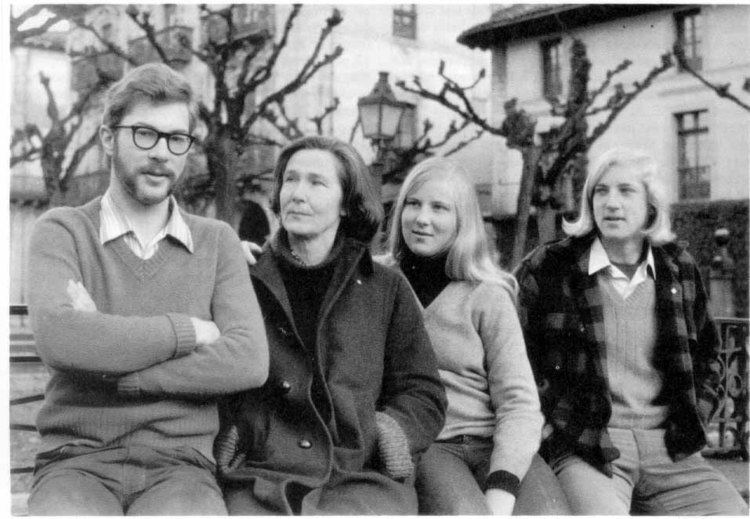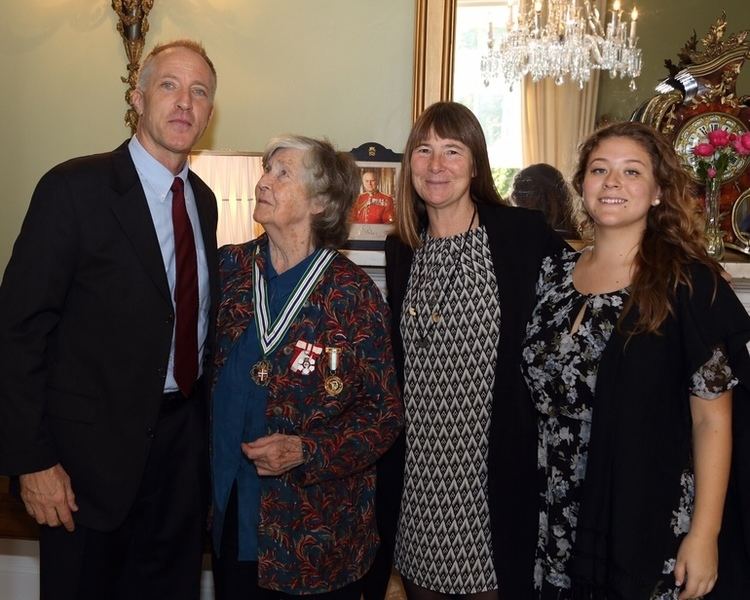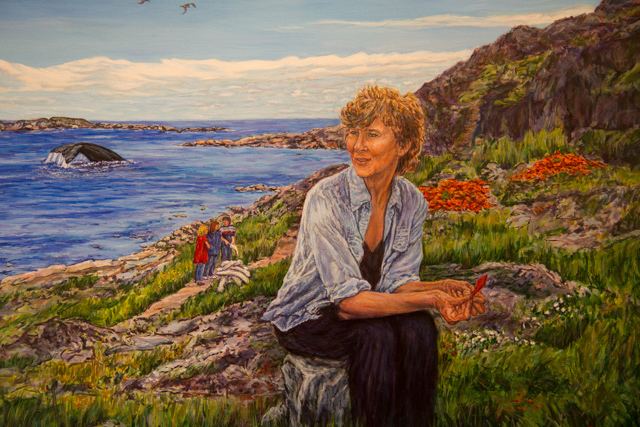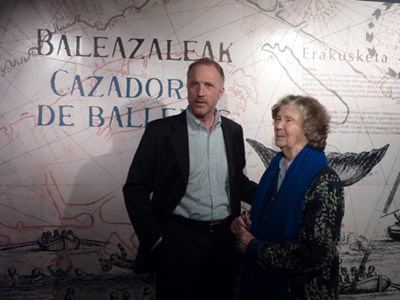 | ||
Books The Basque Coast of Newfoundland | ||
Selma Barkham, OC, (née Huxley; born 1927, London, England) is a Canadian historian and geographer of international standing in the fields of the maritime history of Canada and of the Basque Country.
Contents
- Family and youth
- From England to Canada and the Basque Country
- Conceiving a plan for the future
- Mexico and return to the Basque Country
- Archival finds and historical reconstruction
- Basque destinations in Canada
- Archaeological finds in Labrador and Quebec
- Conferences publications recognition and UNESCO
- Awards and honours
- References

In 1972, as an independent researcher, she moved to the Basque Country to do archival research on an aspect of Canadian and Basque history about which very little was known: Basque fisheries in the old Terra Nova, today some 2,000 kilometres of the Atlantic coast of Canada, in the 16th and 17th centuries.

The research she carried out during the following years, mostly in Basque, Spanish and Portuguese archives, allowed her to make important archival, historical and archaeological discoveries. She found thousands of documents with which she was able to reconstruct most elements of a largely unknown chapter of the history of Canada and of the Basque Country: the Basque cod and whale fisheries in Terra Nova especially in the 16th century. She discovered the existence of a 16th-century Basque whaling industry in southern Labrador and adjacent Quebec, their whaling ports, archaeological remains of their bases, as well as the presence of Basque galleons sunk in those ports, among them the San Juan (1565).

In 1981, she was awarded the Order of Canada for her pioneering work and for having made "one of the most outstanding contributions, in recent years, to the story of this nation". One of those whaling ports found by her, present-day Red Bay, Labrador, has been declared a National Historic Site of Canada (1979) and a World Heritage Site by UNESCO (June 2013).

Family and youth

Selma Huxley was born in England in the midst of a family of intellectuals and scientists. Her father, Michael Huxley, a diplomat and the founder-editor of the Geographical Magazine, whose cousins included the writer Aldous Huxley and his brother the biologist Sir Julian Huxley (first Director General of UNESCO), was a grandson of the eminent English scientist Thomas Henry Huxley known as "Darwin's Bulldog". Her mother, Ottilie de Lotbinière Mills, was a granddaughter of the Canadian politician and conservationist Sir Henri-Gustave Joly de Lotbinière, who was a Cabinet minister in the Government of Canada and Premier of the province of Québec.
She spent her teenage years during the Second World War in England and the United States. When the war ended she studied at the universities of Paris and London.
From England to Canada and the Basque Country
In 1950 she decided to spend some time visiting relatives in Canada where she settled in Montreal, working for the Yellow Pages, as a teacher and finally as the Librarian of the Arctic Institute of North America at the University of McGill.
There, in 1953, she met her future husband a young English architect, Brian Barkham, who was deeply fond of the Basque Country. In the summer of 1950, he had left England on motorcycle, with a fellow student of the University of London, John Stoddart, to study the rural architecture of Andalucía in southern Spain. But, due to various circumstances, he had ended up in the Basque Country studying its caseríos (farmhouses), which would be the subject of his degree thesis. He and his companion made good friends and fell in love with that region, with the result that they returned to the Basque Country in the summer of 1951.
Huxley could not have known then that that meeting was going to change her life so much, nor that in the future her own research on the Basque Country would lead her to make discoveries of importance to Basque and Canadian history. In 1954, the newly married couple moved to Ottawa, the capital of Canada, where Barkham set up an architecture practice and they started a family. Two years later, they visited the Basque Country where a friend, the priest Don Pío de Montoya, spoke to them about the old Basque presence in Canada.
Conceiving a plan for the future
In 1964, aged 37, Selma Barkham was left a widow with four children under the age of ten and had to find a way of making a living. She worked mostly for the National Historic Sites as a historian on various projects. These included the restoration of Louisbourg, the 18th-century French fortress and commercial-fishing port on Cape Breton Island on the Atlantic coast of Canada.
Doing that she became interested in European fishing voyages to that region in previous centuries, especially from the Basque Country with which she had personal ties. She developed a plan to research, in archives of Spain and France, Basque fisheries in Canada in the 16th and 17th centuries, thereby combining her personal and intellectual interests. She knew that for that she would have to learn Spanish, she already spoke English and French.
At that time, the late 1960s, it was recognized that there had been Basque cod fishing and whaling expeditions to Terra Nova in those centuries, but there was very little documentary information about them.
Mexico and return to the Basque Country
In 1969, she decided to move to Mexico with her children by car, where she supported her family as an English teacher. Three years later, in 1972, she applied from there for a grant from the Canada Council to begin her research. Following that, she put her family and belongings aboard a cargo ship bound for the Basque port of Bilbao.
However, she would not begin that research backed and financed by an institution, but rather on her own, with little means and against expectations. Shortly after her arrival in Bilbao, she received the news that her grant application had been turned down. It was thought that that work had already been done.
Barkham found herself without a job, with hardly any money and without clear perspectives. Those were difficult times but she did not give up. She believed that the archives could contain valuable information. During the first year she taught English and studied Spanish paleography in the evening at the University of Deusto. She received a thousand dollars from an anonymous Canadian donor, which allowed her to pay the rent, and she began making her first finds of importance in archives.
On the basis of these, in 1973 she managed to negotiate a contract with the Public Archives of Canada to locate in Spain documentation of interest to Canada. But the contract, which would be renewable, was part-time and there was not a budget for a telephone or car. The rest of the time she pursued her own research. That year she moved to the inland Basque town of Oñati, realizing the richness of the virtually unused Archivo Histórico de Protocolos de Gipuzkoa located there, where she was to live for twenty years.
Archival finds and historical reconstruction
Over the years she researched in some 40 archives - parish, municipal, notarial, judicial, etc. - in places such as Tolosa, Bilbao, Burgos, Valladolid, Madrid, Seville and Lisbon. Little by little she discovered thousands of manuscripts from the 16th and 17th centuries, mostly in old Spanish, relating to the Basque fisheries in Terra Nova: including insurance policies, lawsuits, wills, charter-parties, crew agreements and lists of provisions and equipment. She also gradually found thousands of manuscripts to do with the other sectors of the Basque maritime economy such as shipbuilding, trade and fishing in Europe.
This detailed documentation allowed her to establish that the Basques had carried out, in different specific areas of Atlantic Canada, a prosperous cod fishery as well as a major whale fishery on an industrial scale during the 1500s. Furthering her analysis of these documents, she was able to reconstruct most aspects of those Basque fisheries particularly in the 16th century: their scale and evolution, the organization and financing of the expeditions, types of ships, composition of crews, routes and destinations, fishing and whaling seasons, shipwrecks, the sailors' life, work and death, their food and clothing, contact with Amerindians, markets, etc.
Basque destinations in Canada
Regarding the destination of the ships until the end of that century the manuscripts showed Barkham that, in contrast to the cod fishing vessels, the whalers went to about twelve ports of an area of Terra Nova that the Basques called the "Gran Baya". She studied other written sources, such as sailing directions, and maps and charts of the time in places like the national libraries of England and France.
This enabled her to determine that the codfishers mostly used ports of what is now the south-east of the island of Newfoundland. In relation to the whaling activity she concluded that the "Gran Baya" corresponded to the present-day Strait of Belle Isle, which separates Newfoundland from Labrador, and that the old whaling ports, mentioned in the archival documents, were situated along the north shore of the Strait of Belle Isle, or the south coast of Labrador and a small section of the Quebec coast.
Crucially, she managed to identify the location of most of the individual whaling ports and their modern names. In this way, for example, Gradun became present-day Middle Bay, Puerto Bretón became Carrol Cove and Buttes, the most important port, became Red Bay. Therefore, she had not only made known the existence of a 16th-century Basque whaling industry in Labrador and adjacent Quebec but also their whaling ports.
The archives revealed three unique manuscripts from that century which had been written on that very coast: a sale of chalupas (whaleboats) (1572) and two wills (1577 and 1584). These were the oldest original civil documents written in Canada.
Archaeological finds in Labrador and Quebec
Barkham knew from the documentation that in those ports there had to be remains of the Basque whaling presence, both on land and under water, and she wanted to find them. Backed by her research so far, she organized an archaeological survey expedition to southern Labrador in the summer of 1977, with a grant from the Royal Canadian Geographical Society. She explored several harbours along the coast and discovered archaeological remains of Basque whaling bases, including at Red Bay, thereby confirming her historical work in Europe. The expedition was joined by, among others, archaeologist James Tuck of Memorial University of Newfoundland.
Among the manuscripts found by the researcher are some that refer to the sinking of several 16th-century Basque whaling galleons in specific ports of the "Gran Baya", whose modern names she had identified on the Labrador coast: one from Pasaia (1563) in Los Hornos (Pinware Bay), the Madalena from Mutriku (1565) and the María from San Sebastián (1572) in Chateo (Chateau Bay/Henley Harbour), and the San Juan from Pasaia (1565) and the Madalena from Bordeaux (1574/75) in Buttes (Red Bay).
The year after Barkham's expedition, in 1978, a team of underwater archaeologists from Parks Canada led by Robert Grenier, basing themselves on the historian's discoveries and on the detailed information she had provided them, conducted surveys at Red Bay and Chateau Bay. They located a wreck in both harbours which turned out to be 16th-century whaling ships. The press conference announcing these finds was held at the Public Archives of Canada.
From then on, Barkham continued her historico-geographical work parallel to the land and underwater excavations, under Tuck and Grenier respectively, at Red Bay which was declared a National Historic Site of Canada in 1979.
In 1982, she organized another expedition, this time by sailing boat from Cape Breton Island to southern Labrador and the Quebec North Shore. She identified 17th-century Basque cod fishing locations on the west coast of Newfoundland while, at Middle Bay and Five Leagues Harbour on the Quebec coast, she found further archaeological remains of the 16th-century Basque whaling presence.
Conferences, publications, recognition and UNESCO
This historian has presented the results of her research at numerous conferences and has published widely. Her most complete publication is: S. Huxley [Barkham], ed., Los vascos en el marco Atlántico Norte. Siglos XVI y XVII [The Basques in the North Atlantic in the 16th and 17th Centuries] (San Sebastián: Etor Editorial, 1987). Her work has featured extensively in the media, magazines, books and documentaries. In July 1985 it was, together with the archaeology at Red Bay, cover article of National Geographic magazine.
She has received a number of national and international honours and awards. The press release notifying her appointment to the Order of Canada (1981) refers to the fact that, besides her discoveries in Labrador, she "uncovered a period (1540-1600) in Canadian history about which almost nothing was known". In 1993, Memorial University of Newfoundland awarded her an Honorary Doctorate for having "sparked a wholesale revision of 16th-century Canadian history". In 2009, she was elected Fellow of the international organization Wings WorldQuest, which "recognizes and supports visionary women who are advancing scientific inquiry and environmental conservation".
In June 2013, the Red Bay National Historic Site was declared a World Heritage Site by UNESCO. This declaration reflects the importance of the contribution made by Barkham to the history of the Basque Country and of Canada.
